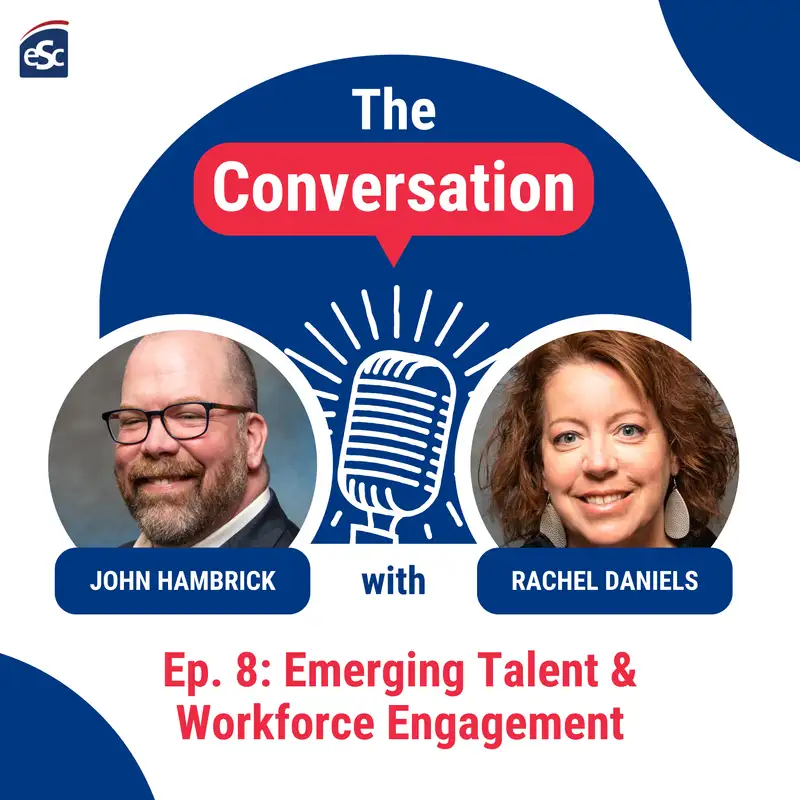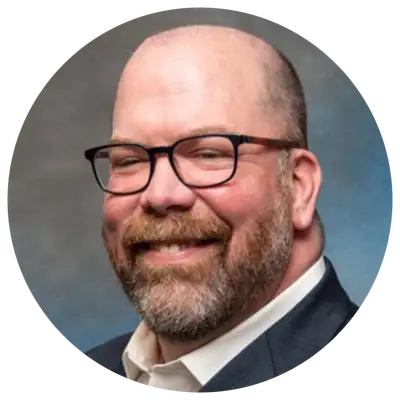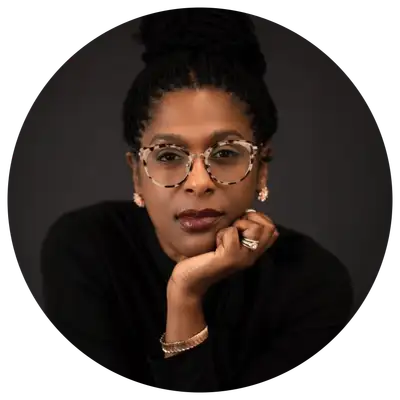
Emerging Talent & Workforce Engagement
Opal Brant:
... And we want to make sure that every teacher, every student, every person in this region understands what those opportunities are, but more importantly, how to access those opportunities.
Speaker 2:
That was Opal Brant, the Emerging Talent Manager at One Columbus. On this episode of The Conversation, John learns about their efforts to support and engage businesses with the region's K through 12 pipeline. Let's dive in.
John Hambrick:
Hello and welcome back to The Conversation, Ohio Voices in Education, igniting ideas, inspiring change. My name is John Hambrick. I'm with the ESC of Central Ohio, and my esteemed host, Rachel Daniels, can't make it today. She's out supporting one of our member districts with the great work that she does. Today for our conversation, I am absolutely delighted to have Opal Brant, who is the Emerging Talent Manager with One Columbus. Opal, welcome to The Conversation.
Opal Brant:
Thank you, John. It's a pleasure.
John Hambrick:
Heck yeah. Hey, we're going to get right into it for our listeners. So can you share with our listeners what the role of economic development is within our K-12 ecosystem? And then I'll do a follow-up, but really why is it important?
Opal Brant:
Yeah, John, that's a great question. Well, economic development is our programs policy or activities that seek to improve the economic well-being and quality of life for a community. And to do all of those things, we have to make sure that we have a skilled workforce ready to enter into these emerging talent, these emerging careers. And as you know, One Columbus has done a wonderful job of bringing a lot of different companies to this region. And in that effort, we need talent supply. And the largest pool of talents who develop are those in the K-12, are our youngest folks. So what our role is now, and especially in my role, is to really make that connection between the business stronger, make the connection between what our economic development needs are as far as industry is well known in the K-12 community. So my role is really working closely with schools in the 11 counties that we serve, particularly in targeted counties, targeted schools that really have a lot of students at large population, just to make sure they're equitable understanding of what our economy needs as far as talent.
John Hambrick:
Heck yeah. Well, I certainly appreciate, and I'm sure our listeners do, is always maintain that equitable lens when it comes to engaging our students into some really cool, rich opportunities. So from your talent manager lens, how are companies supporting the region's K-12 pipeline?
Opal Brant:
Oh yeah, so what we do at One Columbus, we make sure that we are checking in with our existing industries, but also as we're bringing new companies to this region that we really understanding what their job growth projections are. We are really understanding what the industry needs as far as talent supply, as far as the skills that they need our community to need. So the way that companies are leaning into that, and our focus is really to make sure that what we call, we have champions of our key industries. And we do that through supporting, uplifting and scaling educator professional development, helping teachers and other educators understand and be champions of our industry by making sure that they know and have a really good understanding of what our industry needs and what it looks like now.
Because teachers do a great job teaching, but sometimes they don't get the chance to get out, but we want to bring and build those relationships. The other thing is through that is helping with curriculum development. How can companies through their subject matter expertise, add value to curriculum that's being taught in the classroom? And then that flows into work-based learning models, a lot of project-based learning. We want to make sure that our companies are adding value and influence to our educators and to our students by leaning into projects and career-connected learning models. So those are really interesting ways that a lot of our companies are participating in that.
John Hambrick:
I really like the idea of including companies so that they're adding value here. It's not just a one-way, it's a two-way conversation between business and education and how very important that needs to be. And so when you're talking about that and really your teacher exploration, your curriculum development, that career connection, what's a win for a business slash school relationship?
Opal Brant:
Yeah, I mean, thank you. It takes all of us. I mean, for a win for me personally is that everybody does what they do best, so a win for me is that every single one of our educators in this region have an understanding of what the key industries are, have an understanding of the businesses that are in their own backyard and have an understanding of the opportunities that are available to them. A win for me would also be that students have that same understanding, but also that there are clear pathways to access those possibilities. A lot of things people don't know. So for example, a big one, our semiconductor industry is growing and it's new to this region, and there's not that general awareness. And we want to make sure that every teacher, every student, every person in this region understands what those opportunities are, but more importantly, how to access those opportunities. So that will be a win for me that everyone across the board knows no matter what school they go to and everyone has access to those opportunities.
John Hambrick:
How would you consider to a win for that business and education for students in their readiness component, whether that's through the OhioMeansJobs Readiness Seal, how would you imagine there being a win for a prepared student?
Opal Brant:
That our programs like are leveraging those OMJ Readiness Seals. There's a general understanding across the board, a shared understanding of what the OMJ Readiness Seals provide, but also around what are the key credentials that folks need? What are the industry recognized credentials that they need? So I think that sometimes that's a moving target and it may not be a shared understanding for that, but I think that would definitely be a win for me. But I think also what I like to say is that we can look at each school and see how a company is really embedded in that school. I don't want to say adopt a school or anything like that. I want to see a relationship where the company is taking ownership and leadership and accountability over what happens in schools. I mean, not to say they take control, but it is like a partnership, that's the word I'm looking for. It's more of a partnership and that every school can identify easily who their business partners are. That would be a win for me.
John Hambrick:
Amazing. And so whether that's one particular business engaging with that school, but oh my gosh, you mentioned the semiconductor industry, we have a life science industry, the continued booming technology, construction, manufacturing. How is it from One Columbus's perspective of helping educators to better know these industries?
Opal Brant:
Yeah, I think first we want to make sure that the data that we have on a regular basis is shared in a concise way with our education system. We want to make sure in a concise way that the educator boot camps that are going on, whether it's one that's happening in Delaware versus one that's happening in Franklin, that our companies know about those things and are deeply engaged in those opportunities. We want to be able to scale those boot camps. I know that sometimes there may be 35 in a class, there may be 100 class, but how many teachers are there in the community? How do we create scales so every teacher has some type of that access to that?
So I think that that's very important. So what happens in educator bootcamps, I mean, right now what happens at educator boot camps, there's a partnership with companies. The teachers are going to these companies. The teachers are learning from subject matter experts. The teachers are figuring out ways to use the create project-based learning opportunities. They are seeing what equipment is being used in that particular company, and then they're learning with that company how to embed those projects that subject matter expertise in their classroom. So how do they translate what they see in the company to their classroom? Those are some of the things that are happening in educator bootcamps.
John Hambrick:
I love it. A lot of our listeners are workforce readiness practitioners. So whether that's a counselor, a coordinator with a work-based learning internship, how would you recommend some of the strategies for these workforce readiness practitioners on how to engage better with business and industry?
Opal Brant:
Wow, that's a great question. What I've seen sometimes is companies are asked to participate in things, and a lot of times it's on short notice, like two weeks we're having a interview session, want to do mock interviews. My suggestion to workforce practitioners is to really think about how they want to leverage industry as far as do you need them? Mock interviews are great, but how are you leveraging their subject matter expertise and also communicating what the scale will be? What I mean by that is a workforce practitioner can say, "We want you to come into these classrooms next year to impact these many students." Companies understand return on investment, they understand scale, they understand metrics. I think sometimes the way we might communicate with the company, we may not be just taking the most advantage of that relationship. And I think that there are opportunities in that, and we're here to support any work readiness or workforce practitioner to be able to do that.
And also to help them engage with key industries in their region, and maybe it's even understanding who they are. And I think another important thing to note is its important as a workforce practitioner to understand who are you speaking to in that company? A recruiter's lens is going to be very different from the CEO lens or a subject matter expert in a specific area. So think about that when you are ready to make your ask. A recruiter, a lot of time is going to be thinking about, they work in HR, they're going to think about short-term hires. So if you are really wanting someone to come in and do a work-based learning project, that may not be that recruiter, it's going to be potentially someone else within that organization. So my suggestion is to think about who the audience is within even the company that you're thinking about and maybe even doing a little bit of research. And of course, we are here to support that on a company to see who might be the best person to talk to for that specific ask.
John Hambrick:
I was on a call actually earlier today with an HVAC company, and she was asking what could it look like for unified paperwork? Sure, the Ohio Department of Education workforce comes out with a unified work-based learning template.
Opal Brant:
Yes, yes.
John Hambrick:
But then what else could it look like when it's just one piece of paper for anything, or two, but just something that is also consistent district to district. So these organizations, as you mentioned, the lens is different and the capacities for each of those individuals is different.
Opal Brant:
You want to make it easy for the company, if you can make it easier for them, if you can do a lot of the grunt work as far as the ease of paperwork, ease of the ask, making the ask clear, communicating with that company when the timeline is for whatever activities, the better. I think you'll definitely get much more out of that relationship.
John Hambrick:
Amazing. This has been a really incredible conversation and it's been going super fast. I need to slow time down a little bit. I've got another question for you, and this one I think goes a little bit deeper. What would you suggest to our listeners to better connect our emerging workforce into the workforce and also just into our community?
Opal Brant:
I think that that's a great question, and I spend a lot of my days and nights thinking about that. So from my angle, we are looking at how we can help our companies do the things that I talked about, like embed themselves into career awareness opportunities in schools, project-based learning opportunities, capstone projects for some students. How can we help create better pathways into that in our school system? But also we are looking at ways outside of school. So how do students engage regularly? I mean, a lot of students are in youth employment programs that are run by nonprofits. How can we help our companies engage with our youth employment programs to do the same thing?
How can we help them with embedding project-based activities there? Because some companies, as you know well, John May not take on someone under 18 as an intern, but they have subject matter expertise that would be of value to schools that would be of value to any work readiness program or youth employment program. So we are looking at strategies to create cleaner pathways for companies to provide awareness and exposure at every point that we can think of. So we're looking even outside of the school system for summer youth employment programs, even in year round opportunities that are happening to really help add exposure and awareness of our key industries.
John Hambrick:
I think you're right, and I'm sure some of our listeners are like, "Well, how do I get better involved in those nonprofit organizations? How do I get better involved with those workforce readiness organizations that provide the resources?" Duly they step into the school for that readiness component, but then also engage with that student learner after school hours in preparation for whatever path that student, whether that workforce readiness changes their trajectory, it improves their trajectory. I'm sure our listeners are like, "How could I do that? How do I better engage with those organizations as well to enhance what's happening?"
Opal Brant:
Yeah, I mean, I'm looking at it from our lens a lot of different ways, and I mean, we don't have all the answers, but I'll share with you some of the things that we're thinking about. Since we have a strong relationship with companies, we want to help prepare our companies as well, help them build capacity to support whether a school is asking them for something to engage with high school age youth, whether it's a nonprofit that's asking them to engage. We want to help them build capacity. So a part of that is helping them understand if they're taking on an in-person interns, how to engage with that youth, how to create a meaningful work experience. What does Project-based look like for them in classroom?
A company, they are subject matter experts in what they do. It may not be how that looks in a classroom. We want to help companies build capacity and prepare to do that. We also want to, like I had mentioned before, really help spread the word about all the things that are happening in our region and point our companies to that in a clear and concise way. We want to support the work of educator professional development via our companies, whether it be traditional teachers and also CTE instructors. How are we doing that?
So we have three pilots that we're working on this year to really look at how we might be able to better support and have everyone do what they do best. So one of that is that employer onboarding that we're going to do for those companies that are interested in working with emerging talent. We are looking at how can we bring educators together and companies together to build out a work-based learning model that can be used in the classroom. We're looking at how to do those things. So yeah, John, I mean, it's going to take all of us. I don't have all the answers, but I mean, I'm certainly dedicated to connecting to subject matter experts in the education field as well as with companies to see how we can create great partnerships.
John Hambrick:
Being in workforce development for a while, sometimes you just think, "Hey, I just get to make those connections." But now when you blend in with education, it really is for those employers, community connectors. It's lifelong learning. It's not a better connect. And Opal, thank you so much for being that conduit, that connector, that fulcrum to help our business and industry better connect into our K-12 ecosystem. Our community is for the better having you where exactly where you're at today. So thank you so much. And wow, and what a great conversation we had today. We missed our colleague Rachel Daniels, but stay tuned into the podcast link. You can learn more about Opal and her bio. You can learn more about some of the links about One Columbus and the work that they're doing throughout the central Ohio region. And again, from Rachel and me. Thanks so much for tuning into today's conversation and we look forward to our next conversation.
Creators and Guests

